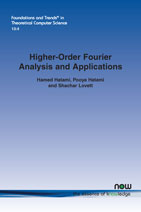Higher-order Fourier Analysis and Applications
By Hamed Hatami, McGill University, Canada, hatami@cs.mcgill.ca | Pooya Hatami, Ohio State University, USA, pooyahat@gmail.com | Shachar Lovett, UC San Diego, USA, slovett@cs.ucsd.edu
Abstract
Fourier analysis has been extremely useful in many areas of mathematics. In the last several decades, it has been used extensively in theoretical computer science. Higher-order Fourier analysis is an extension of the classical Fourier analysis, where one allows to generalize the “linear phases” to higher degree polynomials. It has emerged from the seminal proof of Gowers of Szemerédi’s theorem with improved quantitative bounds, and has been developed since, chiefly by the number theory community. In parallel, it has found applications also in theoretical computer science, mostly in algebraic property testing, coding theory and complexity theory. The purpose of this book is to lay the foundations of higherorder Fourier analysis, aimed towards applications in theoretical computer science with a focus on algebraic property testing.
Higher-order Fourier Analysis and Applications
Higher-order Fourier Analysis and Applications provides an introduction to the field of higher-order Fourier analysis with an emphasis on its applications to theoretical computer science. Higher-order Fourier analysis is an extension of the classical Fourier analysis. It has been developed by several mathematicians over the past few decades in order to study problems in an area of mathematics called additive combinatorics, which is primarily concerned with linear patterns such as arithmetic progressions in subsets of integers.
The monograph is divided into three parts: Part I discusses linearity testing and its generalization to higher degree polynomials. Part II present the fundamental results of the theory of higher-order Fourier analysis. Part III uses the tools developed in Part II to prove some general results about property testing for algebraic properties. It describes applications of the theory of higher-order Fourier analysis in theoretical computer science, and, to this end, presents the foundations of this theory through such applications; in particular to the area of property testing.
